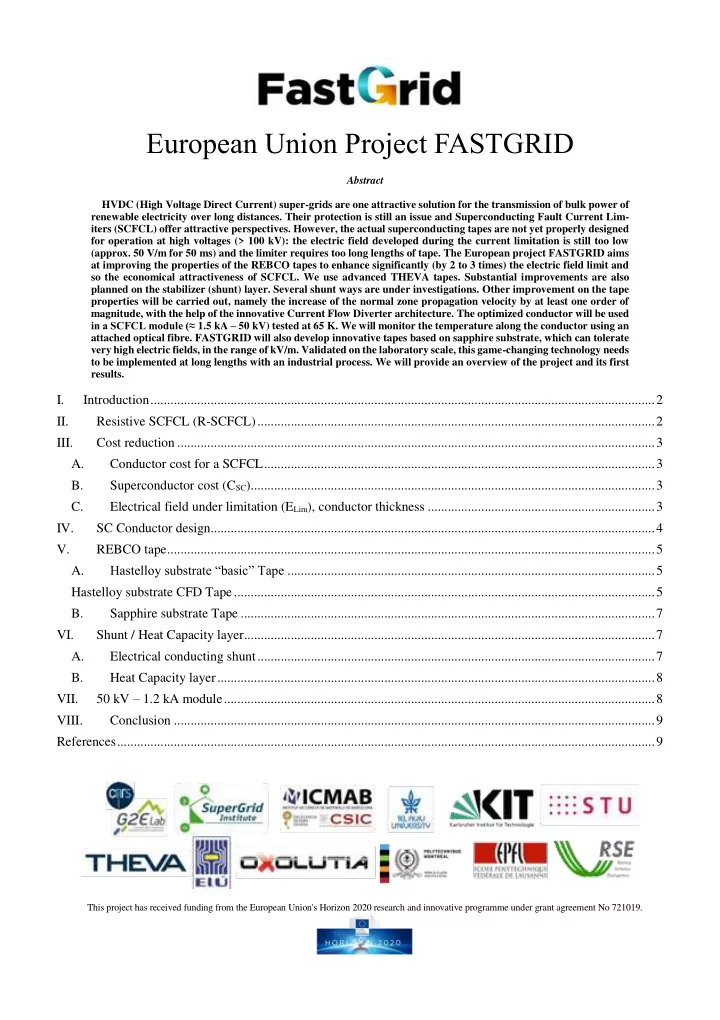

European Union Project FASTGRID Abstract HVDC (High Voltage Direct Current) super-grids are one attractive solution for the transmission of bulk power of renewable electricity over long distances. Their protection is still an issue and Superconducting Fault Current Lim- iters (SCFCL) offer attractive perspectives. However, the actual superconducting tapes are not yet properly designed for operation at high voltages (> 100 kV): the electric field developed during the current limitation is still too low (approx. 50 V/m for 50 ms) and the limiter requires too long lengths of tape. The European project FASTGRID aims at improving the properties of the REBCO tapes to enhance significantly (by 2 to 3 times) the electric field limit and so the economical attractiveness of SCFCL. We use advanced THEVA tapes. Substantial improvements are also planned on the stabilizer (shunt) layer. Several shunt ways are under investigations. Other improvement on the tape properties will be carried out, namely the increase of the normal zone propagation velocity by at least one order of magnitude, with the help of the innovative Current Flow Diverter architecture. The optimized conductor will be used in a SCFCL module (≈ 1.5 kA – 50 kV) tested at 65 K. We will monitor the temperature along the conductor using an attached optical fibre. FASTGRID will also develop innovative tapes based on sapphire substrate, which can tolerate very high electric fields, in the range of kV/m. Validated on the laboratory scale, this game-changing technology needs to be implemented at long lengths with an industrial process. We will provide an overview of the project and its first results. I. Introduction ....................................................................................................................................................... 2 II. Resistive SCFCL (R-SCFCL) ....................................................................................................................... 2 III. Cost reduction ............................................................................................................................................... 3 A. Conductor cost for a SCFCL ..................................................................................................................... 3 B. Superconductor cost (C SC )......................................................................................................................... 3 C. Electrical field under limitation (E Lim ), conductor thickness .................................................................... 3 IV. SC Conductor design..................................................................................................................................... 4 V. REBCO tape .................................................................................................................................................. 5 Hastelloy substrate “basic” Tape .............................................................................................................. 5 A. Hastelloy substrate CFD Tape .............................................................................................................................. 5 B. Sapphire substrate Tape ............................................................................................................................ 7 VI. Shunt / Heat Capacity layer ........................................................................................................................... 7 A. Electrical conducting shunt ....................................................................................................................... 7 B. Heat Capacity layer ................................................................................................................................... 8 50 kV – 1.2 kA module ................................................................................................................................. 8 VII. VIII. Conclusion ................................................................................................................................................ 9 References ................................................................................................................................................................. 9 This project has received funding from the European Union's Horizon 2020 research and innovative programme under grant agreement No 721019.
I. I NTRODUCTION H IGH Voltage Direct Current (HVDC) Supergrids appear as one of the best solutions to integrate huge amounts of renewable energies, one key for the sustainable development. It must move considerable energies from offshore wind farms or photovol- taic farms to customers. As its name indicates it is a HVDC grid. DC is required inter alia due to the cables between the wind farms and the coast and HV results from a technico-economical optimization like in AC. If DC shows numerous advantages compared to AC, one of its main drawbacks is the difficulty to cut the fault currents since the current does not cross naturally zero like in AC. HVDC Supergrids link different energy sources to several points of the traditional AC grids and so are inher- ently multi-terminal. The fault current must be then cut on the DC side to provide selectivity; it means the isolation of only the faulty part. The “classical” half bridge powe r converters between the AC and DC sides cannot manage the fault currents. Full bridge converters could do this but are much more expensive and show higher losses. There is no consensus about the protec- tion of HVDC Supergrids. One solution could be to associate an inductance to a hybrid breaker [1]. This solution remains expensive, shows losses and requires space. Several studies show that the Superconducting Fault Current Limiter (SCFCL) offers an attractive solution for the protection of HVDC grids [2][3]. The first economic calculations based on the Eccoflow conductor [4] with a limitation electric field of 50 V/m (50 ms) and a tape at 200 €/kA/m show prohibitive costs. That is the origin of the H2020 European FASTGRID project (Cost effective FCL using advanced superconducting tapes for future HVDC grids) . FASTGRID [5] aims to develop “low cost” robust REBCO conductors for the SCFCLs by working on the conductor including a breakthrough solution (sapphire substrate) and its environment. The effectiveness of the solutions will be tested on a 50 kV – 1.5 kA module (designed as a basic element of a HV device). FASTGRID project started in January 2017 and gathers 12 academic or industrial partners: CNRS Grenoble (coordinator), SuperGrid Institute, CSIC/ICMAB, Ox- olutia, THEVA, RSE, EPM, TAU, KIT, IEE, EPFL and STU. II. R ESISTIVE SCFCL (R-SCFCL) The Resistive SCFCL (R-SCFCL) is simply a SC element immersed in a cryogenics fluid (liquid nitrogen) in a cryostat and connected to the grid through two connexions called current leads (Fig. 1) and a switchgear. Fig. 1. Resistive SCFCL. The R-SCFCL is based on the intrinsic highly non-linear characteristic of the electric field versus current density of a su- perconductor (Fig. 2). The critical engineering current density (J ce ) corresponds to a critical electric field (E c ). The international standard for HTS is E c = 100 µV/m. The very high value of J ce must be noticed. For comparison typical current densities in copper are about a few MA/m 2 . Fig. 2. Characteristic electric field versus engineering current density of a superconductor at 77 K (left) and at different temperatures (right)
Recommend
More recommend